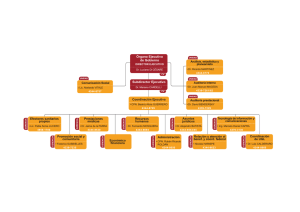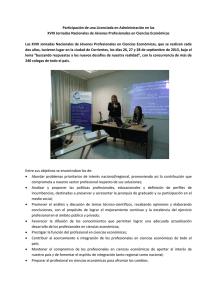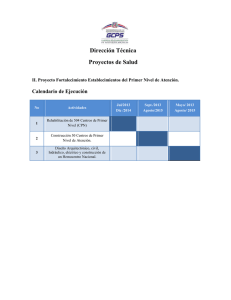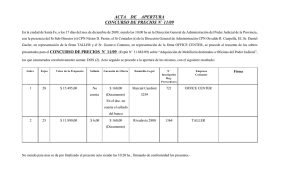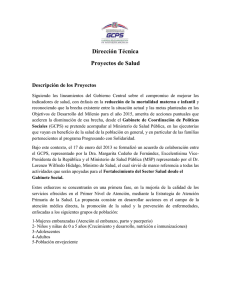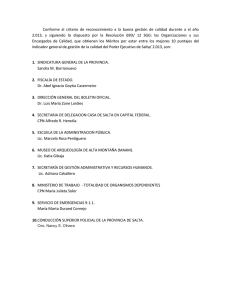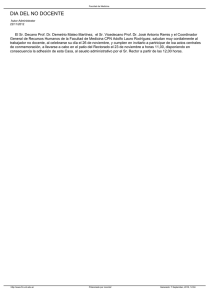1 UNIVERSIDAD SAN FRANCISCO DE QUITO Can brain cells
Anuncio
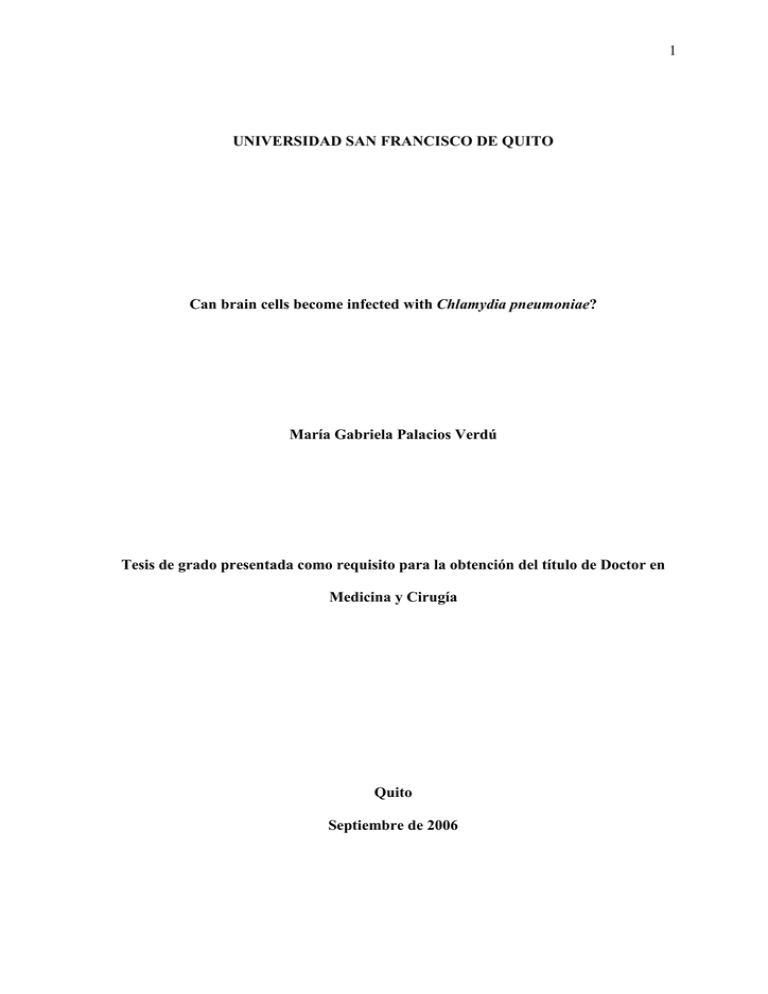
1 UNIVERSIDAD SAN FRANCISCO DE QUITO Can brain cells become infected with Chlamydia pneumoniae? María Gabriela Palacios Verdú Tesis de grado presentada como requisito para la obtención del título de Doctor en Medicina y Cirugía Quito Septiembre de 2006 2 Universidad San Francisco de Quito Colegio de Ciencias de la Salud HOJA DE APROBACION DE TESIS Can brain cells become infected with Chlamydia pneumonia? María Gabriela Palacios Verdú Director de la Tesis …………………………………… Miembro de Comité de Tesis ……………………………………. Miembro de Comité de Tesis ……………………………………. Miembro de Comité de Tesis ……………………………………. Decano del Colegio de Ciencias de la Salud ……………………………………. Quito, septiembre de 2006 3 © Derechos de autor María Gabriela Palacios Verdú 2006 4 Resumen La relación entre enfermedades neurodegenerativas y la infección por Chlamydia pneumoniae (Cpn) ha sido ampliamente estudiada, obteniendo resultados conflictivos. Sin embargo, la mayoría de estos estudios han sido realizados en tejido post-mortem. El presente estudio, realizado en septiembre 2004 en el laboratorio de microbiología del hospital de la Universidad de Maastricht, Holanda, fue la primera investigación in Vitro. Tres tipos de células de cerebro de ratones; microglia, astrositos y neuroblastos; fueron infectadas con Cpn. Estas células fueron cultivadas y un grupo de células de cada tipo fueron infectadas con Cpn y el grupo control con una solución de sucrosa fosfato y glucosa. Luego de lo cual se añadió dos tipos de anticuerpos para que se unan a la bacteria. Se seleccionó los siguientes cortes de tiempo: 1, 3, 6, 12, 24, 48, 72 horas y 1 y 2 semanas. Se estudió la infección por medio de tinción inmunofluorescente. Los resultados obtenidos demuestran que los diferentes tipos de células pueden ser infectados, siendo los astrositos los más susceptibles. En conclusión Cpn puede infectar y replicarse en todas las líneas celulares, el número de células disminuye conforme avanza el tiempo y hay una diferencia en susceptibilidad entre los diferentes tipos de células. 5 Abstract The relationship between neurodegenerative diseases and Chlamydia pneunomia’s infection (Cpn) has been investigated by many studies obtaining conflicting results. But most of these have been carried out in post-mortem tissue. The present study was done in the microbiology laboratory in the university hospital of Maastricht, in Holland, and is the first in vitro. Three types of mouse brain cells; microglia, astrocytes and neuroblasts; were infected with Cpn. These cells were cultivated and groups of each type of cells were infected with Cpn and the other with a control solution of sucrose, phosphate and glucose. Afterwards two types of antibodies were used to bond to the Cpn. The time points selected to observe Cpn infection was 1, 3, 6, 12, 24, 48 and 72 hours, and 1 and 2 weeks. This was done using immunofluorescence staining. The results obtained show that Cpn can infect all cell lines, astrocytes being the most susceptible to Cpn’s infection. In conclusion Cpn is able to infect and replicate in the different cell lines, the number of cells in each group diminish as time increases and there is a difference in susceptibility in the different cell lines. 6 Table of Contents 1. Resumen iv 2. Abstract v 3. Resumen extenso en español 1 4. Introduction 11 5. Materials and Methods 15 6. Results 18 7. Discussion 30 8. Recommendations 33 9. Bibliography 34 7 List of Figures 1. Chlamydia pneumoniae (Cpn) Cell Cycle 12 2. Microglial cell control 1 hour post infection 18 3. Microglial cell Cpn 1 hour post infection 18 4. Astrocytes cell control 1 hour post infection 18 5. Astrocytes cell Cpn 1 hour post infection 18 6. Neuroblast Cpn 1 hour post infection 19 7. Microglial cell control 3 hours post infection 19 8. Microglial cell Cpn 3 hours post infection 19 9. Neuroblast control 3 hours post infection 20 10. Neuroblast Cpn 3 hours post infection 20 11. Microglial cell control 6 hours post infection 20 12. Microglial cell Cpn 6 hours post infection 20 13. Astrocytes control 6 hours post infection 21 14. Astrocytes Cpn 6 hours post infection 21 15. Neuroblast control 6 hours post infection 21 16. Neuroblast Cpn 6 hours post infection 21 17. Microglial cell Cpn 12 hours post infection 22 18. Neuroblast Cpn 12 hours post infection 22 19. Astrocytes control 12 hours post infection 22 20. Astrocytes Cpn 12 hours post infection 22 21. Microglial cell control 24 hours post infection 23 22. Microglial cell Cpn 24 hours post infection 23 23. Microglial cell control 48 hours post infection 23 8 24. Microglial cell Cpn 48 hours post infection 23 25. Neuroblast control 48 hours post infection 24 26. Neuroblast Cpn 48 hours post infection 24 27. Astrocytes control 48 hours post infection 24 28. Astrocytes Cpn 48 hours post infection 24 29. Microglial cell control 72 hours post infection 25 30. Microglial cell Cpn 72 hours post infection 25 31. Astrocytes control 72 hours post infection 25 32. Astrocytes Cpn 72 hours post infection 25 33. Neuroblast control 72 hours post infection 26 34. Neuroblast Cpn 72 hours post infection 26 35. Microglial cell control 1 week post infection 26 36. Microglial cell Cpn 1 week post infection 26 37. Astrocytes control 1 week post infection 27 38. Astrocytes Cpn 1 week post infection 27 39. Neuroblast control 1 week post infection 27 40. Neuroblast Cpn 1 week post infection 27 41. Microglial cell control 2 weeks post infection 28 42. Microglial cell Cpn 2 weeks post infection 28 43. Astrocytes control 2 weeks post infection 28 44. Astrocytes Cpn 2 weeks post infection 28 45. Neuroblast Cpn 2 weeks post infection 29 Resumen Extenso en Español ¿Pueden las Células del Cerebro Infectarse con Chlamydia pneumoniae? 9 Introducción.La Chlamydia pneumoniae u organismo TWAR pertenece al grupo de bacterias cocos no motiles que actúan como parásitos dentro de la célula eucariótica (Becker 2000). Existen dos tipos de morfologías de Chlamydia: el cuerpo elemental (EB) y el cuerpo reticulado (RB). El EB es la forma infecciosa pero que no puede replicarse (Becker 2000). Esta morfología es transmitida de persona a persona por gotas respiratorias. Infecta y se divide en macrófagos, monocitos, células endoteliales y células del músculo liso (Yucesan 2001). El RB es la forma intracitoplasmática no infecciosa que se divide por fusión binaria (Balows 1998). Su ciclo vital (Figura # 1) comienza con la adherencia del EB a los receptores de la célula huésped, luego de lo cual entra a la célula por medio de los procesos de endocitosis y / o fagocitosis. Una vez dentro de la célula, comienza el ciclo intracelular del EB, siendo la primera fase de tipo durmiente en la que tiene muy poca actividad metabólica. Luego, el EB inicia su metabolismo y de esta manera comienza el proceso de conversión a RB (Becker 2000). Cuando el RB ha crecido se divide por fusión binaria y da como resultado más de un RB dentro de una vacuola endocítica llamada cuerpo de inclusión (Ballows 1998). Después de su crecimiento y conversión a EB, estas nuevas partículas son liberadas al destruirse la célula huésped ya sea por lisis celular o exocitosis (Balin et 2001). 10 La incidencia de infección con Cpn es de 200,000 – 300,000 casos por año (Murray et al. 2004). Cpn es un patógeno respiratorio común que causa infecciones respiratorias agudas y en casos más severos, enfermedad pulmonar obstructiva crónica (Balin 2001). A este organismo también se lo ha relacionado con enfermedades como la meningoencefalitis, esclerosis múltiple, aterosclerosis y la enfermedad de Alzheimer (AD) de inicio tardío (Balin 2001). Existe mucha controversia acerca de la relación entre las enfermedades neurodegenerativas y la infección con Cpn. Balin et. al. encontraron que 17 de 19 pacientes con AD eran PCR positivos para Cpn comparado con aquellos pacientes sin AD, de los cuales 18 de 19 eran PCR negativos (2001). Otros estudios han sido realizados, pero hasta el momento ninguno ha podido obtener resultados similares (Wozniak 2003; Gieffers et. al. 2000 y Ring et. al. 2000). Debido al cuestionamiento acerca de la relación de Cpn con las enfermedades neurodegenerativas, primero queremos investigar si las células del cerebro pueden ser infectadas con Cpn. En este estudio utilizamos 3 tipos de células: neuronas, astrocitos y células de la microglia. Las neuronas son células muy vulnerables a los diversos procesos patológicos que ocurren dentro del cerebro. Pueden ser afectadas de manera directa o indirecta, como en el caso de AD o en la demencia asociada al HIV (Mattson 2004). 11 Los astrocitos forman parte de la barrera hémato-encefálica y por lo tanto se cree que juegan un papel protectivo en el intercambio de químicos entre el sistema circulatorio y el tejido cerebral (Crossman 2000). Las interacciones entre astrocitos y neuronas pueden ser clasificados en 5 grupos según Hatton y Purpura: homeostasis, metabólica, señalización, tróficas y patológicas (2004). Las células de la microglia tienen un papel fagocitario en el sistema nervioso central (Crossman 2000). En el cerebro lesionado estas células son activadas (Burt 1993) y tienen un papel neuroprotectivo y regenerativo (Streit 2002). Durante el proceso de desarrollo promueven la migración y crecimiento axonal, y la diferenciación terminal de diferentes tipos de neuronas (Vilhardt 2005). Por lo tanto el objetivo de este estudio es infectar tres tipos de células del cerebro: astrocitos, microglia y neuroblastos con Cpn. Su tropismo será visualizado con anticuerpos inmunofluorescentes. Materiales y métodos.Este es un estudio cualitativo, en el cuál se seleccionó a tres tipos de células de cerebro de ratones; microglia, astrositos y neuroblastos; las cuales fueron obtenidas comercialmente. Un grupo de cada tipo de célula fue infectado con una solución de Chlamydia pneumoniae y otro grupo con una solución control, como será explicado luego. En este estudio no se calculó la muestra debido al tipo de estudio. 12 1). Preparación del medio.Para las células de la microglia se utilizó el medio de “Dulbecco´s Eagle” suplementado con L-glutamina, suero fetal de ternero y hepes. El medio modificado de Kaighn se utilizó para los neuroblastos, al cuál se le añadió suero de caballo y suero fetal de ternero. En el caso de los astrocitos se utilizó el medio de “Dulbecco´s Eagle” preparado con L-glutamina y suero de caballo. En los medios de infección de las tres líneas celulares se cambió la cantidad de sueros suministrados y se añadió ciclohexamida. 2). Cultivo celular.Todas las líneas celulares fueron cultivadas en frascos de cultivo de 250 mL con 15 mL de su medio respectivo y almacenadas en la estufa a 37 °C con 5% de CO2. Cada 48 horas las células eran divididas. Para este procedimiento primero las células eran lavadas con solución de PBS (solución buffer de fosfato), luego tripsina fue añadida por 10 minutos. Para parar su mecanismo se añade por lo menos la misma cantidad de medio, y finalmente se divide y se almacenan las células en la estufa de CO2. 3). División de platos de 24 pozos.Se realiza el mismo procedimiento que para la división de células. Luego de añadir el medio se cuenta el número de células vivas en cada frasco. 13 Gracias a ensayos realizados antes de este estudio se sabe que para tener una capa confluente de células luego de 24 horas se necesita 5 x 105 células en el caso de los astrocitos y neuroblastos, y 1 x 105 en las células microgliales. Para que las células se adhieran al pozo se añade una solución de PBS + 1% de gelatina. Luego de 15 minutos esta solución se absorbe y se coloca la solución de células dentro de cada pozo. Finalmente los platos son almacenados dentro de la estufa. 4). Infección con Cpn y control.Luego de 24 horas de almacenar las células, éstas son infectadas con Cpn con una multiplicidad de infección de 5 unidades formadoras de inclusión por célula. Para infectar las células, se centrifugan los platos por 1 hora a 4500 RPM a 20 °C. Luego se lavan los pozos con PBS y se añade medio fresco, para luego almacenarlos en la estufa. Para el control se siguieron los mismos pasos pero en vez de Cpn se utilizó una solución de sucrosa, fosfato y glucosa (SPG). 5).- Detección de Cpn por inmunofluorescencia.Los cortes de tiempo seleccionados para observar el tropismo de Cpn fueron: 1, 3, 6, 12, 24, 48 y 72 horas; y 1 y 2 semanas. 14 Primero las células son fijadas con metanol y lavadas con PBS. Luego se coloca en los pozos una solución de PBS + 0.05% de BSA (solución de albúmina bovina) para disminuir la tinción de fondo. Después se añade el anticuerpo primario monoclonal de ratón anti-chlamydia agitando los platos por 45 minutos, a 37 °C. Luego los pozos son lavados con PBS y se añade el segundo anticuerpo de burro IgG anti-ratón en las mismas condiciones que con el primer anticuerpo. Luego de 45 minutos se lava nuevamente los pozos con PBS y se añade una solución de PBS + azul de Evan para visualizar las células. Después de 20 minutos de mantener cubiertos se cubren los platos, se lavan los pozos con PBS. Finalmente se observan los platos bajo el microscopio de inmunofluorescencia. Resultados.• 1 hora post – infección.- En este momento los EB se están adhiriendo a las células y en el 90% de ellas ya están siendo endocitados los EB (Figura # 2, 3, 4, 5 y 6). Este proceso es el mismo en todas las líneas celulares. • 3 horas post – infección.- Todos los EB se encuentran dentro de la célula. Se observa que la mayoría de las células contienen Cpn (Figura # 7, 8, 9 y 10). • 6 horas post – infección.- 15 En este momento el ciclo de división celular comienza con la transformación de EB a RB. Se observa que ciertas células exhiben gran cantidad de señal positiva, comparadas con otras que no tienen señal. Lo que demuestra que Cpn sólo puede replicarse en ciertas células (Figura # 11, 12, 13, 14, 15 y 16). • 12 horas post – infección.- La reorganización de EB a RB todavía está en proceso. Las imágenes son similares a las de 6 horas. De la misma manera se observa que ciertas células presentan más puntos fluorescentes que otras (Figura # 17, 18, 19 y 20). • 24 horas post – infección.- Los RB ya están formados y comienzan a agruparse para formar el cuerpo de inclusión. El tamaño de la señal fluorescente es mayor (Figura # 21y 22). En este momento las diferencias entre los tres tipos celulares son muy notorias. En las células de la microglia se observa pocas células infectadas con Cpn, mientras que en los neuroblastos la mayoría tienen una señal positiva. • 48 horas post – infección.- Los cuerpos de inclusión ya están completamente formados y dentro de ellos el proceso de reorganización de RB a EB ha iniciado (Figura # 23, 24, 25, 26, 27 y 28). 16 Mientras avanza el tiempo, las diferencias entre las líneas celulares son mayores. En la microglia Cpn se replica en un bajo número de células. Mientras que en los neuroblastos una gran cantidad de células emiten una señal positiva para Cpn. En los astrocitos aún se observa una mayor cantidad de células infectadas. • 72 horas post – infección.- El ciclo de Cpn se ha completado, y en cualquier momento la célula será destruida para liberar los EB recién formados para infectar a células vecinas (Figura # 29, 30, 31, 32, 33 y 34). • 1 semana post – infección.- Todavía se observa señal positiva, lo que significa que Cpn puede replicarse y que los EB recién formados pueden infectar a otras células. En este momento Cpn se encuentra en diferentes estadios de replicación celular (Figura # 35, 36, 37, 38, 39 y 40). • 2 semanas post – infección.- Todavía se observa que algunas células exhiben una señal positiva, por lo tanto Cpn continúa dividiéndose. Sin embargo se observa que hay un menor número de células infectadas que a la semana de post infección. Nuevamente podemos ver que Cpn se encuentra en diferentes estadios de su replicación celular (Figura # 41, 42,43, 44, 45). 17 En conclusión, podemos decir que hay una clara diferencia de susceptibilidad a la infección con Cpn de las tres líneas celulares. Las células de la microglia siendo las menos afectadas, ya que luego de dos semanas muy pocas células exhiben una señal positiva. Y los astrocitos las más susceptibles, que presentan mayor cantidad de células infectadas con Cpn durante los diferentes cortes de tiempo. Discusión.Hasta el momento todos los estudios realizados para investigar la relación entre enfermedades neurodegenerativas y la infección con Cpn han sido en tejido post – mortem obteniendo resultados contradictorios (Balin et al 2001; Ring et. al. 2000; Gieffers et. al. 2000). Sin embargo, todavía no se ha logrado demostrar en experimentos in Vitro que Cpn puede infectar las células del cerebro. Por este motivo decidimos estudiar el tropismo de Cpn in Vitro en algunas células del cerebro: microglia, astrocitos y neuroblastos. Nuestro estudio demuestra que la infección con Cpn es posible, ya que luego de infectar las células exhiben una señal inmunofluorescente positiva comparado con el grupo control en los diferentes cortes de tiempo. La señal positiva es dada por los cuerpos infecciosos que están adheridos o dentro de la célula, ya que aquellos que estaban sueltos fueron lavados luego de añadir Cpn. Los resultados de nuestro estudio fueron reproducibles, ya que dos ensayos anteriores demuestran resultados 18 similares y cada condición fue estudiada tres veces, haciendo nuestro estudio más seguro. También demostramos que Cpn puede replicarse en estas líneas celulares, ya que luego de la primera y segunda semana todavía se observa señal positiva comparada con el grupo control. Esto se debe a que a las 72 horas y a la semana de infectarles, los platos son centrifugados para permitir que los EB recién liberados infecten a otras células. Otro hallazgo importante es que mientras avanza el tiempo el número de células infectadas con Cpn disminuye. Todavía no se sabe si esto se debe a que Cpn sólo puede replicarse en ciertas células, o si las células infectadas mueren, ya sea por apoptosis o necrosis. Sin embargo, observamos que en ambos grupos se perdían células luego de cada lavada (post infección, a las 72 horas, 1 semana), esto también puede explicar el por qué se observa un menor número de células conforme pasa el tiempo. Por otro lado también podemos observar diferencias dentro de las líneas celulares en cuanto a la susceptibilidad a Cpn, la cual aumenta conforme pasa el tiempo. Esto puede deberse a que la entrada de Cpn a la célula sea mediada por receptores externos específicos, como es el caso de la infección con HIV (Glass et al 2001). Por lo tanto la diferencia en la magnitud de infección puede estar relacionada con la expresión de estos receptores externos. Otra posible explicación es que ciertos tipos de 19 células son más vulnerables que otras a la bacteria y a las toxinas liberadas por las células infectadas, como es el caso de las neuronas. En este estudio tuvimos dificultades con el cultivo de la línea celular de los astrocitos. Las células no crecían luego de cierto tiempo de ser divididas. Sin embargo, nos aseguramos que esto no se debe a contaminación, ya que cada vez que se usaba un nuevo lote se cambiaba el medio. Otra posible explicación es que estas células pueden tener un límite de divisiones, luego de lo cual dejan de crecer. A pesar de no tener todos los cortes de tiempo, con las imágenes obtenidas se puede observar grandes diferencias a comparación con las células de la microglia. El establecer una relación de causalidad entre Cpn y enfermedades neurodegenerativas causaría un gran impacto en la detección y prevención de está infección. Causaría cambios en el manejo de procesos patológicos como la enfermedad de Alzheimer o la esclerosis múltiple. 20 Recomendaciones.En este estudio demostramos que la infección de células del cerebro con Cpn es posible, sin embargo todavía quedan muchas preguntas por responder. Para confirmar que las células pueden ser infectadas con Cpn se debería realizar un estudio de PCR para detectar el DNA de Cpn. Para verificar la replicación de Cpn se debería transferir el medio y las células infectadas a una capa de detección. Para explicar porque luego de la primera y segunda semana de infección hay menos células, se debería ver si éstas se vuelven apoptóticas o necróticas, o si Cpn influye en esta disminución. También se debería investigar las causas que provocaron que los astrositos no puedan sobrevivir más allá de dos divisiones. Introduction.- Chlamydia pneumoniae (Cpn) belongs to a group of non-motile coccoid bacteria that act as parasites inside the eukaryotic cell (Becker 2000). The family Chlamydiaceae consists of one genus Chlamydia and three species: C. trachomatis, C. psittaci and C. pneumoniae or TWAR organism (Murrey et. al. 2004). This genus is pathogenic for humans and for mammalian, avian and invertebrate hosts (Balows 1998). Chlamydia has two distinct cell morphologies: an elementary body (EB) and a reticulate body (RB). The EB is a non-replicating and infectious particle (Becker 2000), with a diameter of 200 – 300 nm (Balows 1998). It has a rigid outer membrane that makes it resistant to harsh conditions outside their host cell (Murrey et. al. 2004). The EB is transmitted from person to person by respiratory droplets and it infects and replicates 21 mostly in macrophages, monocytes, endothelial cells and vascular smooth muscle cells (Yucesan 2001). The RB is the non-infectious intracytoplasmic form that undergoes replication by binary fusion (Balows 1998) and has a diameter of 0.5 – 0.6 um (Murrey et. al. 2004). Their developmental cycle (figure 1) starts with the attachment of the EB to host cell receptors; afterwards it is internalized by endocytosis and / or phagocytosis. Within the host’s cell endosome the EB undergoes an intracellular cycle, starting with a dormant phase in which it has little or no metabolic activity. Later the EB initiates its metabolism by increasing DNA biosynthesis, so that the process of becoming a RB can start (Becker 2000). Once the RB has grown, it divides by a binary fusion producing more than one RB within an enlarged endocytic vacuole called the inclusion (Ballows 1998). After their formation, these newly formed particles mature and become EB. After which, are released from ruptured host cells (Becker 2000) by cell lysis or via exocytosis (Balin et al 2001). In other cases this last stage continues for an undetermined time because the organism may remain viable inside the host cell by evading lysosomal degradation, resulting in chronic infections (Balin et al 2001). Chlamydia pneumoniae’s infection is very common, with an incidence of 200,000300,000 cases per year in the United States (Murrey et. al. 2004). Cpn seroconversion starts at 4 years of age and by the sixth decade approximately 70% are positive (Yucesan 2001). Cpn is a known respiratory pathogen causing acute respiratory infections: bronchitis, sinusitis, pneumonia and in more severe cases chronic obstructive pulmonary disease (Balin 2001). Apart from respiratory manifestations, this organism has been related to meningoencephalitis, multiple sclerosis, atherosclerosis and late onset sporadic Alzheimer’s disease (AD) (Balin 2001). 22 Figure 1.- Cpn cell cycle. Obtained from: http://www.med.sc.edu:85/mayer/chl-life.jpg Nevertheless there is a lot of controversy regarding the relationship between neurodegenerative diseases and Cpn infection. Balin et. al. found in their study that 17 out of 19 patients with AD were PCR positive for Cpn compared with nonAD patients, among which 18 of 19 were negative (2001). This was confirmed with the use of electron and immunoelectric microscope, immuno-labeling and RT PCR (Balin 2001). But other studies haven’t been able to reproduce these results. Wozniak et al tested AD samples for Cpn by PCR and couldn’t detect any Cpn DNA. (2003). The same occurred in other studies: Gieffers et. al. 2000 and Ring et. al. 2000, who also used PCR. Because of the discussions about a possible role of Cpn in neurodegenerative diseases, we first want to investigate if brain cells can indeed be infected by Cpn. 23 There are two main groups of brain cells: neurons and glial cells. There are 10^10 neurons in the human brain. Its function is to receive and transmit information from and to other neurons or affect organs (Crossman 2000). These cells are very vulnerable and can be direct or indirectly affected by different pathological conditions in the brain. For example, the AB deposits seen in Alzheimer’s Disease cause neuronal cell death by inducing changes in their metabolism (Mattson 2004). But they are also injured by an altered immune response, since AB activates microglial cells and alters astrocytes function (Mattson 2004). This is also seen in infectious processes such as HIV-associated dementia, where HIV does not infect neurons but they are damaged because of proteins released from infected cells (Mattson 2004). Neuronal well-being depends highly on this other group of cells called the glia. There are three distinct cell types in the glial group: oligodendrocytes, astrocytes and microglia (Crossman, 2000). Astrocytes are part of the blood-brain barrier, therefore it is thought that they play a protective role in the exchange of chemicals between the circulatory system and brain tissue (Crossman 2000). According to Hatton and Parpura astrocytes-neuronal interaction can be classified in five groups: homeostatic, metabolic, signaling, trophic and pathologic. In the homeostatic interaction, the astrocyte’s functions is to uptake or redistribute potassium, water and glutamate that is released by neurons to prevent these substances to reach toxic concentrations in the extracellular space. Metabolically it is involved in many pathways, such as: the glutamate-glutamine cycle, ammonium fixation and energy production. It also releases many trophic factors that enhance synapse formation and axonal directed growth. All this interactions are done through signaling mechanisms, such as glutamate release by astrocytes (Hatton, Parpura 2004). 24 Microglial cells have a phagocytic role in the central nervous system (Crossman 2000) and therefore they also have a very close relationship with neurons. They become activated in response to injury (Burt 1993). This is regulated by soluble mediators and cell-to-cell contact (Vilhardt 2005). In the development process they promote migration, axonal growth and terminal differentiation of different types of neurons (Vilhardt 2005). In the injured brain they play a neuroprotective and progenerative role (Streit 2002). Activated microglial cells deliver growth factors that help neuronal degeneration (Streit 2002) and removes inhibitors of axonal reconstitution (Barrow 1995). Therefore, the objective of this study is to infect three different brain cell lines; astrocytes, microglia and neuroblasts with Cpn. Its tropism will be visualized with inmunofluorescence antibodies. 25 Materials and methods.This is a qualitative study in which three types of commercially available mouse brain cells; microglia, astrocytes and neuroblasts, were infected either with Cpn or a control solution. Because of the type of study the sample was not calculated. 1). MEDIUM PREPARATION: Dulbeccos Eagle Medium (GIBCO) supplemented with 2 mM of L-glutamine, 10 % of fetal calf serum and 5 mM of hepes was used to culture the microglial cell line (provided by Finland). For infection we used the same culture medium but we added 2 % of fetal calf serum, 2 mM of L-glutamine, 5 of hepes and 0.031 ug/mL of cyclohexamide. For neuroblasts (ATCC) we used Kaighn's Modification F-12k Medium (GIBCO) and added 10 % of horse serum and 2.5 % of fetal calf serum. The same medium was applied for infection, but we added 3 % of horse serum, 0.5 % of fetal calf serum and 0.5 ug/mL of cyclohexamide. Finally, astrocytes (ATCC) were cultured in Dulbecco's Eagle medium (GIBCO) prepared with 4 mM of L-glutamine and 10 % of horse serum. For infection we used the same medium, but we added 4 mM of L-glutamine, 2 % of horse serum and 0.5 ug/mL of cyclophosphamide. 2). CELL CULTURING.The different cell lines were grown in 250 mL culture flasks with 15 mL of their respective medium and stored in a 5 % CO2 stove at 37 °C . Every 48 hours the cells are divided using different ratios: astrocytes and neuroblasts 1:3 and microglial cells 1:6. First, the cells were washed with PBS (phosphate buffer solution), afterwards trypsin was applied for 10 minutes to de-attach the cells. Then, the workup mechanism of trypsin was stopped by adding at least the same quantity of their respective medium, finally the cells 26 are divided and stored in the CO2 stove. 3). CELL DIVISION IN 24 - WELL PLATES.Follow the same procedure as for cell splicing. After adding the medium, the number of living cells present in each flask are counted by making a solution of the medium with tryptan blue in a counting chamber. Before the beginning of this study, trials were done to know the cell concentration needed to get a confluent layer of cells after 24 – hours of culturing the plates. The results obtained are: for astrocytes and neuroblasts 5 x 105 cells and for microglial cells 1 x 105 cells. PBS + 0.1 % gelatin solution was added to each well of the plate to help maintain the attachment of the cells. After 15 minutes, the PBS + 1 % gelatin solution is absorbed and cell solution is put in each well. Finally the cells are stored in the 5 % CO2 stove at 37 °C. 4). INFECTION WITH CHLAMYDIA PNEUMONIAE AND CONTROL.After 24 hours of growing in the 24-wells plates, the cells can be infected with Cpn Strain TWAR 2043 (ATCC) using a multiplicity of infection (MOI) of 5, which means that 5 inclusion forming units are delivered per cell. The infection was performed by centrifugating the plates for 1 hour at 4500 RPM and 20 °C. Then the plates were washed with PBS and fresh medium was added before storing them in the stove. As a control we used the same procedure, but this time with SPG (sucrose, phosphate and glucose) solution. 5). CPN DETECTION BY IMMUNOFLUORESCENCE.The time points selected to observe Chlamydia pneumoniae tropism was: 1, 3, 6, 12, 24, 48 and 72 hours; and 1 and 2 weeks. This was done using immunofluorescence staining. The cells are fixated with methanol and washed with PBS. Then the cells are preincubated with PBS + 0.05 % of BSA (Bovine solution albumin) to diminish the back screen of staining. 27 Afterwards our primary mouse monoclonal antibody anti-Chlamydia (DAKO) is added to the wells for 45 minutes, at 37 °C by shaking. Next the wells are washed with PBS and our second antibody donkey anti-mouse IgG (Molecular Probes) is added at the same conditions as before. After 45 minutes the wells are washed and PBS + Evan’s blue solution is placed on the wells to visualize the cells. Leave covered for 20 minutes and wash with PBS. After washing, the plates are observed under the immufluorescence microscope (Zeiss). 28 Results.• One hour post infection.At this time point the EB are attaching to the host cell and in approximately 90 % of the cells these start to be endocytized. Figure 2.- Microglial cell control 1 hour post infection Figure 4.- Astrocytes cell control 1 hour post infection Figure 3.- Microglial cell Cpn 1 hour post infection Figure 5.- Astrocytes Cpn 1 hour post infection 29 Figure 6.- Neuroblast Cpn 1 hour post infection This is seen in all these cell lines. • Three hours post infection.All the EB's have entered the cell. It is observed that the number of cells that harvest Cpn is more or less the same. Figure 7.- Microglial cell control 3 hours post infection Figure 8.- Microglial cell Cpn 3 hours post infection 30 Figure 9.- Neuroblasts control 3 hours post infection Figure 10.- Neuroblasts Cpn 3 hours post infection There are still no major differences between the three cell lines but with the microglial cell it is striking that some cells display more positive signal than others. • Six hours post-infection.At this time point the replication cycle starts with the transition from EB to RB. It is observed that there are some cells with a high green positive signal and others that have none. This proves that Cpn cannot replicate in all cells. Figure 11.- Microglial cell control 6 hours post infection Figure 12.- Microglial cell Cpn 6 hours post infection 31 Figure 13.- Astrocytes control 6 hours post infection Figure 15.- Neuroblasts control 6 hours • post infection Figure 14.- Astrocytes Cpn 6 hours post infection Figure 16.- Neuroblasts Cpn 6 hours post infection Twelve hours post-infection.The reorganization from EB to RB still is in process. The image is quite the same as the seen at 6 hours. Again some cells in each group show more green fluorescent dots than others. 32 Figure 17.- Microglial cell Cpn 12 hours post infection Figure 19.- Astrocytes control 12 hours post infection • Figure 18.- Neuroblasts Cpn 12 hours post infection Figure 20.- Astrocytes Cpn 12 hours post infection 24 hours post-infection.The RB's are formed and start to group together to form the inclusion body. The size of the fluorescent signal has grown. 33 Figure 21.- Microglial cell control 24 hours post infection Figure 22.- Microglial cell Cpn 24 hours post infection Now the differences between the three cell lines are pronounced. In the microglial cells we can see that only few cells are infected with Cpn, while in the neuroblasts almost all of them are. • 48 hours post-infection.The inclusion bodies are now completely formed. Inside the reorganization from RB to EB starts again. Figure 23.- Microglial cell control 48 hours post infection Figure 24.- Microglia Cpn 48 hours post infection 34 Figure 25.- Neuroblasts control 48 hours post infection Figure 27.- Astrocytes cell control 48 hours post infection Figure 26.- Neuroblasts Cpn 48 hours post infection Figure 28.- Astrocytes Cpn 48 hours post infection As the time increases, the differences become more notorious than before. In the microglial cell line Cpn replicates only in a small number of cells, while in the neuroblasts there is a large amount of cells infected. In the astrocytes we observe even a higher number of infected cells. 35 • 72 hours post-infection.Cpn’s cell cycle is completed, at any moment the cell will lyse to release the newly formed EB’s, who can infect neighboring cells. Figure 29.- Microglial cell control 72 Figure 30.- Microglial cell Cpn hours post infection 72 hours post infection Figure 31.- Astrocyte control 72 hours post infection Figure 32.- Astrocytes Cpn 72 hours post infection 36 Figure 33.- Neuroblasts control 72 hours post infection • Figure 34.- Neuroblasts Cpn 72 hrs post infection One week post-infection.It is observed that there is still a positive signal meaning that Cpn was able to replicate and newly formed infectious bodies can infect other cells. At this time point the Cpn is at different stages of replication. The differences at the first replication cycle are still visible. Figure 35.- Microglial cell control 1 week post infection Figure 36.- Microglial cell Cpn 1 week post infection 37 Figure 37.- Astrocyte control 1 week post infection Figure 39.- Neuroblast control 1 week post infection • Figure 38.- Astrocyte Cpn 1 week post infection Figure 40.- Neuroblast Cpn 1 week post infection Two weeks post-infection.Some cells continue to give a positive signal, so Cpn continues to replicate. Compared to the time point above, there are fewer cells infected. Again Cpn is seen at different stages of replication. 38 Figure 41.- Microglial cell control 2 weeks post infection Figure 43.- Astrocytes control 2 weeks post infection Figure 42.- Microglial cell Cpn 2 weeks post infection Figure 44.- Astrocytes Cpn 2 weeks post infection 39 Figure 45.- Neuroblasts Cpn 2 wks post infection In short, by looking at the results obtained it is clear that between these three cell lines there are major differences regarding their susceptibility to Cpn infection. Microglial cells being the least affected since only few cells are infected after 2 weeks and astrocytes the most affected having the majority of the cells with a positive immunofluorescent signal through out the different time points. 40 Discussion.Some studies have been performed regarding the relationship between neurodegenerative diseases and Cpn infection, but until now most of them have been carried out in post – mortem tissue obtaining conflicting results. For example with Alzheimer’s disease (AD), Balin et al. described a very strong correlation between AD and Cpn (Balin et al 2001), while four other studies found no association what so ever (Ring et al 2000, Gieffers et al 2000). The same occurred with multiple sclerosis (MS), there still aren’t definitive results to support a causal relationship with Cpn (Yucesan et al 2001, Furrows et al 2004). Other investigations have focused in explaining the mechanism of Cpn entrance of into the brain. MacIntyre et al found that the infection of monocytes and brain endothelial cells might result in the transmigration of infected and uninfected monocytes through the blood brain barrier (MacIntyre et al 2003). Until now no in vitro experiment has been performed demonstrating that Cpn can infect brain cells. That is why we decided to study Cpn’s tropism in some important brain cells in vitro: microglial cells, astrocytes and neuroblasts. In our study Cpn infection is demonstrated by a positive immunofluorescence signal at different time points post infection compared to the negative control. The positive signal shows the infectious bodies that were either attached or inside the cell, since the ones that are loose are washed away after infection. Our results were reproducible, since two trials were performed showing similar results and every condition have been studied in triple, making our study more reliable. We also demonstrate that Cpn is able to replicate in these cells lines, as we still have a positive signal at 1 and 2 weeks post – infection compared with the control 41 group. This is based because that after 72 hours and at 1 week post – infection the plates are centrifuged to allow the new released EB’s to infect other cells. Another important finding is that as time passed by the number of cells infected with Cpn diminished. It is still unknown if this is because Cpn is unable to replicate in all cells and in the rest is unable to survive, or because the infected cell die either by apoptosis or necrosis. Several studies with monocytes and epithelial cells have found that Cpn inhibits apoptosis by IL-10 induction during infection (Rajalingam et al 2001, Haranaga et al 2001), meaning that maybe the infected cells continue to live in order for Cpn to replicate but the infected cells may release toxins that can damage neighboring cells. But we observed that in the infection and in the control group, cells were lost after every wash (after infection, 72 hours and 1 week post – infection), so it can also be due to this. From our results we also observe a difference in susceptibility to infection between microglial cells, neuroblasts and astrocytes that is more striking as time passes by. This could be explained by the fact that Cpn entry into the cell maybe mediated by specific external receptors, as in the case of HIV – infection that requires the presence of the surface protein CD4 as it’s primary receptor and the chemokine receptor CCR-5 to enter the cell. Therefore the differences observed in the amount of infection is related to the expression of these external receptors, microglial cells are greatly infected since they express high levels of both of these receptors, while neurons don’t because they do not express CD4 (Glass et al 2001). Another possible explanation is that one cell is more vulnerable than the other to the bacteria and to the toxins released by the infected cell, for instance neurons. 42 In this study we encountered a difficulty with the culture of the astrocyte cell line. The cells stopped growing after a certain time of being divided. We made sure that this wasn’t because of contamination, since the medium used was changed every time a new batch was used. A possible explanation is that these cells might have a limit in the number of passages, after which they stop growing. Even though not all the time points were done, with the ones shown we still can see major differences compared with the microglial cell line. If a relationship between Cpn and neurodegenerative diseases is proven, it will have a great impact in the detection and prevention of this infection since Cpn infection is very common. It will cause changes in the management of many pathological processes, such as AD or MS, since antibiotics could be given to slow the progression of the disease. Vaccine development against Chlamydia spp. (Brunham et. al. 2000) are being studied and this could be a way to prevent infection. 43 Recommendations.So we demonstrated that infection of brain cells with Cpn is possible, but there are still a lot of questions unanswered so future studies are required. To confirm that the cells become infected with Cpn a PCR study should be performed to detect Cpn's DNA. Transfer of medium and infected cells to a detection layer is also needed to verify Cpn replication. Experiments to detect if the cells become apoptotic or necrotic after infection and if that explains why at 1 and 2 weeks post – infection we see less cells infected. The reasons why the astrocyte cell line stopped growing after a certain number of cells divisions should be studied in future investigations. 44 Bibliography.Anderson, Christopher M. and Raymond A. Swanson. “Astrocyte Glutamate Transport: Review of Properties Regulation, and Physiological Function.” GLIA 32 (2000) 1-14. Balin, Brian J. and Denah M. Appelt. “Role of Iinfection in Alzheimer's disease.” JAOA 101.12 Suppl S (2001) S1-S6. Balin Brian J., et al. “Identification and Localization of Chlamydia pneumoniae in the Alzheimer Brain.” Med Microbiol Immunol 187 (1998) 23-42. Ballows, Albert and Bryan Duerden. “Chlamydia.” In Systematic Bacteriology. 9th Edition, 2 vols. 1998. Barrow, Kevin D., “The Microglial Cell: A Historical Review.” Journal of Neurological Sciences, 134 Suppl 1 (1995) 57-68. Becker, Yechiel. “Chlamydia.” in Baron's Medical Microbiology, 4th Edition. 2000. Online: http://gsbs.utmb.edu/microbook/ch039.htm . 20/09/04. Brunham, R. C., et al. “The Potential for Vaccine Development Against Chlamydial Infection and Disease.” The Journal of Infectious diseases, 181 Suppl 3 (2000) 538-543. Burt, Alvin M. Textbook of Neuroanatomy. International Edition. USA: W.B. Saunders Company, 1993. Cho-Chou Kuo, et al. “Chlamydia pneunoniae (TWAR).” Clinical Microbiology Reviews (1995) 451-461. Crossman, A. R. and D. Neary. Neuroanatomy, An illustrated colour text. 2nd ed. London: Harcourt Publishers Limited, 2000. 45 Fernández, F., et al. “A New Microimmunofluorescence Test for the Detection of Chlamydia pneumoniae Specific Antibodies.” Journal of Basic Microbiology 44 (2004) 275-279. Furrows, S J., et al. “Chlamydophilia pneumoniae infection of the Central Nervous System in Patients with Multiple Sclerosis.” Journal Neurol Neurosurg Psychiatry 75 (2004) 152-154. Gaydos, Charlotte A., et al. “Replication of Chlamydia pneumoniae In Vitro in Human Macrophages, Endothelial cells, and Aortic Artery Smooth Muscle Cells.” Infection and Immunity 64.5 (1996) 1614-1620. Gieffers, Jens, et al. “Failure to Detect Chlamydia pneumoniae in Brain Sections of Alzheimer’s Disease Patients.” Journal of Clinical Microbiology 38.2 (2000) 881-882. Glass, Jonathan D. and Steve L. Wesselingh. “Microglia in HIV-associated neurological diseases.” Microscopy research and technique 54 (2001) 95-105. Haranaga, Shusakau, et al.”Chlamydia pneumoniae Infects and Multiplies in Lymphocytes In Vitro.” Infection and Immunity 69.12 (2001) 7753-7759. Hatton, Glenn I. and Vladimir Parpura. Glial, Neuronal Signaling. California: Kluwer Academic Publishers, 2004, 1-16. Hudson, Alan P. “What is the Evidence for a Relationship Between Chlamydia pneumoniae and Late-Onset Alzheimer’s Disease?” Laboratory Medicine 11.32 (2001) 30-35. MacIntyre, A., et al. “Chlamydia pneumonia Infection Promotes the Transmigration of Monocytes Through Human Brain Endothelial Cells.” Journal of Neuroscience Research 71 (2003) 740-750. 46 Mattson, Mark P. “Infectious Agents and Age-related Neurodegenerative Disorders.” Ageing Research Reviews 3 (2004) 105-120. Minagar, Alireza, et al. “The Role of Macrophage/ Microglia and astrocytes in the Pathogenesis of three neurologic disorders: HIV-associated dementia, Alzheimer disease, and multiple sclerosis.” Journal of the Neurological Sciences, 202 (2002) 13-23. Murrey, et al. “Chlamydia.” Medical Microbiology. 3rd ed. Chapter 44. 2004. Online: http://www.med.sc.edu:85/mayer/chlamyd.htm . 27/09/04 Rajalingam, Krishnaraj, et al. “Epithelial Cell Infected with Chlamydia pneumoniae (Cpn) are Resistant to Apoptosis.” Infection and Immunity 69.12 (2001) 7880-7888. Ring, Robert H. and Joseph M. Lyons. “Failure to Detect Chlamydia pneumoniae in the Late-Onset Alzheimer’s Brain.” Journal of Clinical Microbiology 38.7 (2000) 2591-2594. Streit, Wolfgang J. and Carol A. Kincaid-Colton. “The Brain’s Immune System.” Scientific American (1995) 54-61. Streit, Wolfgang J. “Microglia as Neuroprotective Immunocompetent Cells of the CNS.” GLIA 40 (2002) 133-139. Stratton, Charles W. and Subramaniam Sriram. “Associations of Chlamydia pneumoniae with Central Nervous System Disease.” Microbes and Infection 5 (2003) 1249-1253. Vilhardt, F., “Microglia: Phagocyte and Glia Cell.” The International Journal of Biochemistry and Cell Biology, 37 (2005) 17-21. Wozniak, Matthew A., et al. “Absence of Chlamydia pneumoniae in Brain of Vascular Dementia Patients.” Neurobiology of Aging 24 (2003) 761-765. 47 Yucesan, Canan and Subramaniam Siriam. “Chlamydia pneumonia infection of the Central Nervous System.” Current Opinion in Neurology 14 (2001) 355-359.
